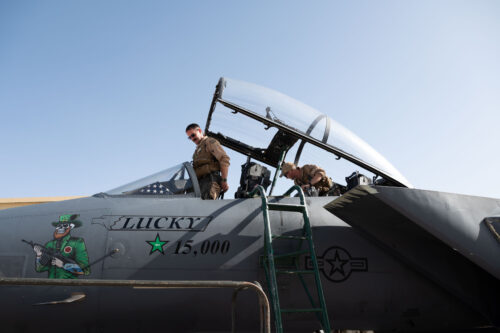A U.S. Air Force F-15E Strike Eagle, tail number #89-0487 and nicknamed “Lucky,” has achieved a remarkable feat, surpassing 15,000 flight hours during a combat sortie on May 17. This accomplishment marks a significant milestone for this Strike Eagle which is the only F-15E credited with an air-to-air kill.

“Lucky” is currently deployed within the U.S. Central Command area of responsibility. This particular aircraft entered service in 1989, and dedicated maintenance crews have ensured its continued airworthiness for nearly 35 years.
The achievement underscores the crucial role played by maintenance personnel in keeping these complex aircraft operational throughout their lifespans. It also highlights the durability and reliability of the F-15E platform, which has seen extensive deployment in operations like Desert Storm, Enduring Freedom, and Inherent Resolve.
Originally delivered to the 4th Fighter Wing at Seymour Johnson Air Force Base in 1989, “487” was assigned to the 335th Fighter Squadron. On Feb. 14, 1991, Captains Richard T. Bennett (pilot) and Daniel B. Bakke (weapon systems operator) flying “487” became the first and only F-15E crew to achieve an air-to-air victory.
Responding to a distress call from Special Forces facing down three Iraqi Mi-24 Hind helicopter gunships, Captains Bennett and Bakke, already airborne on a Scud patrol mission, were diverted to engage the threat.
After maneuvering through challenging weather and evading anti-aircraft fire, the crew identified the Hinds on their targeting pod and observed them deploying troops to surround the Special Forces team.
The Strike Eagle crew initially planned to attack the lead helicopter with a laser-guided GBU-10 bomb while it was on the ground. However, as the bomb was released, the helicopter took off. Despite their radar indicating the helicopter was gaining altitude, the weapon systems officer maintained laser designation.
Moments later, a massive explosion engulfed the Mi-24, disintegrating it nearly 245 meters above the ground, according to Special Forces estimates. The remaining Hinds retreated, allowing the Special Forces team to safely withdraw.
“Lucky’s” exceptional achievement in surpassing 15,000 flight hours during a combat mission adds another chapter to its remarkable story. This accomplishment not only signifies the dedication of maintenance crews but also highlights the F-15E’s enduring capabilities and adaptability.
For more information, hit the Source below
Let’s retire “Lucy” to the National Museum of the Air Force preferably next to the just inducted double Mig killers! Both deserve to be enshrined together.
I mean Lucky!